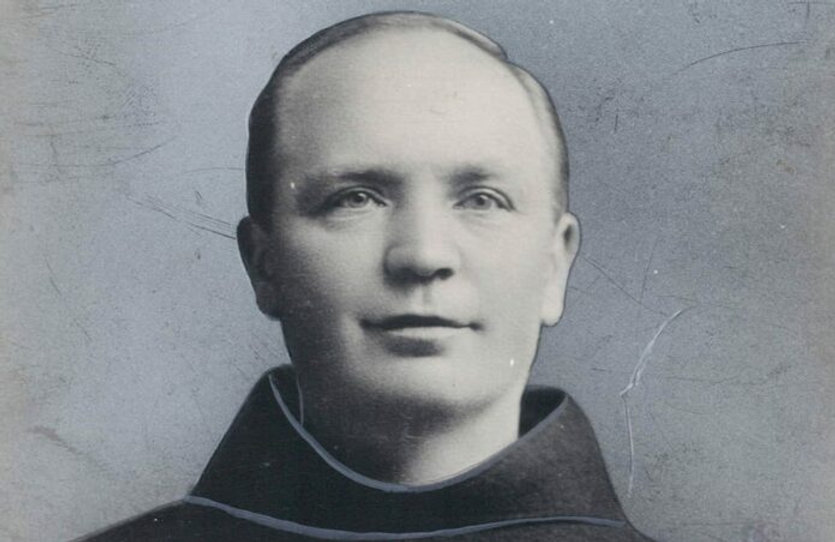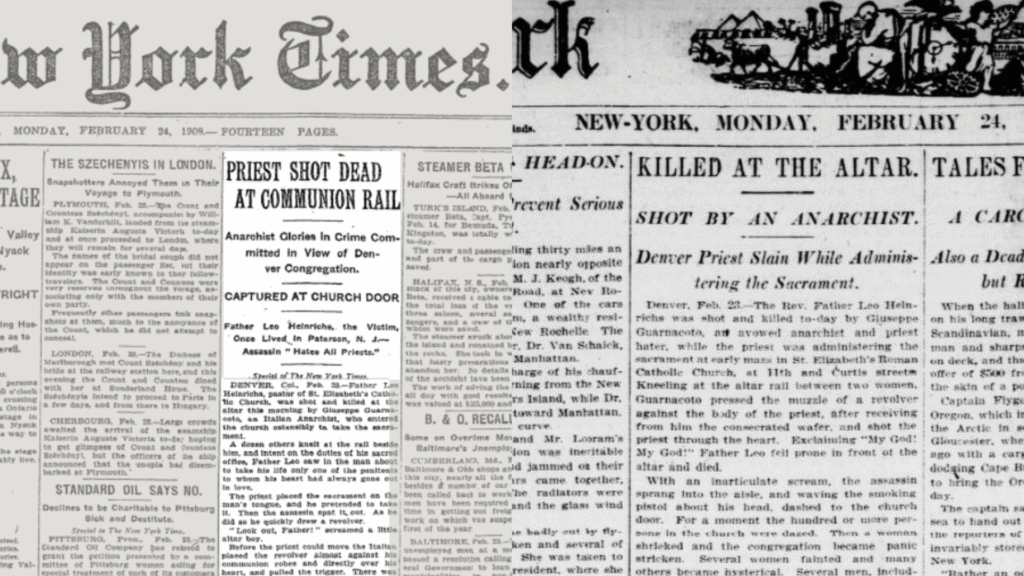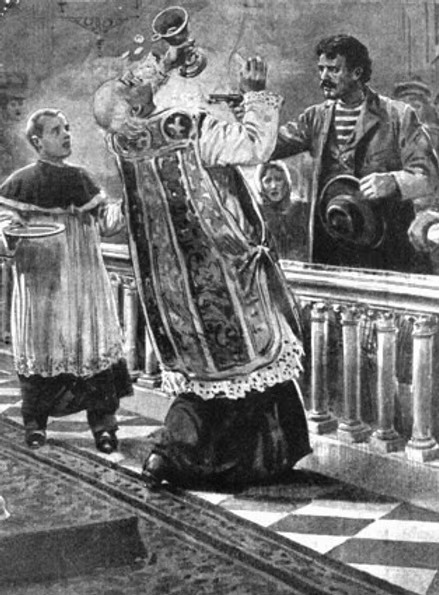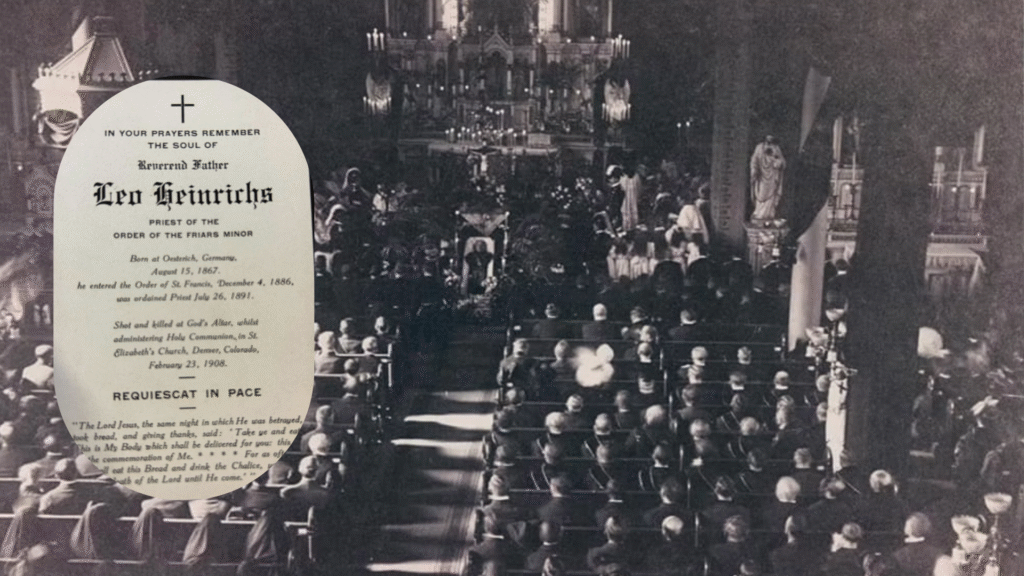

The Catholic Patriotic Minute: Father Leo Heinrichs
Catholics For Catholics Special Edition | August 11th, 2025
Father Leo Heinrichs: Protector of the Holy Eucharist
On February 24, 1908, the New York Times headline on the first page read, “PRIEST SHOT DEAD AT COMMUNION RAIL.” The first-page headline of another nation-wide newspaper, New-York Tribune, read “KILLED AT THE ALTAR. SHOT BY AN ANARCHIST. Denver Priest Slain While Administering the Sacrament.” What these headlines and articles did not capture, however, were the truly extraordinary moment that followed the assasination of Father Leo Heinrichs on February 23, 1908, and the daily acts of charity and mortification that made Father Leo ready to meet the end of his earthly life.

In Oestrich, an archdiocese of Cologne, Germany, Joseph Heinrichs was born on August 15, 1867, the Solemnity of the Assumption of Our Lady. When he was nineteen, Joseph sought discernment in the Fransiscan Order in Fulda. However, he, along with the Franciscans, fled from persecution in Germany. Under the rule of Chancellor Otto von Bismarck in the late nineteenth century, Germany was becoming an empire. The chancellor viewed the Catholic Church as a significant threat to their nation-state; as a result, he instigated a course of numerous conflicts, known as the Kulturkampf, to claim state control over the Church.
And so, in 1886, Joseph left his homeland for the New World all in pursuit of becoming a priest. On December 4 of the same year, he became a novice and received his Franciscan habit and the name Leo, at the Franciscan Order at Saint Bonaventure’s in New Jersey. On July 26, 1891, he was ordained as a priest, and he remained in New Jersey to serve those at Saint Bonaventure’s and Holy Angels parish for eleven years.
Father Leo became the pastor of Saint Stephen’s in Croghan, New York, in April 1902. Here, he led the efforts in swiftly rebuilding the church, school, convent and monastery at Saint Stephen’s after a fire. Soon, he was sent back to Saint Bonaventure’s, where he was remembered largely for extensively serving the sick during the smallpox outbreak there in Paterson, New Jersey.

In September of 1907, Father Leo Heinrichs received his last assignment at Saint Elizabeth’s Church in Denver, Colorado, where he would be the pastor and the monastery’s superior. Despite only serving this parish for five months before his death, Father Leo had offered himself in acts of service for his parishioners, and his parishioners loved and appreciated him in return. One of his fellow priests in Denver, Father Eusebius, would recount after his death,
[H]e was untiring in his efforts for the betterment of his people, and his zeal, rather than his authority, inspired his co-workers. Although he had been in our midst only five months he had endeared himself to all. The poor, especially, have lost in him a true friend. He fed many daily at his door; he visited the sick and secured for them . . . the medical [supplies] and other necessary attention. Only true men can win the confidence and love of a child. In our parish today there are no hearts heavier than those of the little children to whom he was indeed a father. He took upon himself the special care of the children and found a favorite in each.
Although he quickly became a part of the community at Saint Elizabeth’s, Father Leo desired to see his family in Germany. He was finally allowed to visit them after twenty-three years away, but he would only leave Denver after he prepared seventy children for the Sacrament of the Holy Eucharist and administered the Sacrament to them on June 7, 1908. However, he would be called to a different Home before June came around.

On the morning of February 23, 1908, Father Leo offered Mass at six in the morning for about sixty people. He usually said Mass at eight, but he switched Mass times with another priest on this specific day. When he distributed Holy Communion to a man later named as Giuseppe Alia, Alia spat the Eucharist, Christ’s Body, onto the ground, raised his revolver to Father Leo’s chest, and shot him straight through the heart. What is a typical reaction to being shot in the heart? Perhaps, simply crouching on the ground or behind something for cover is normal. Father Leo’s immediate reaction was to gather the Eucharist from the ground in order to protect the Body of Jesus Christ from desecration. Father Leo placed the ciborium holding the Eucharist onto the steps of the altar dedicated to the Blessed Virgin and kneeled down. Father Eusbeius later stated that Father Leo “gave himself the Holy Viaticum,” which is one’s last Eucharist before death, and “was absolved and anointed by Father Walston.” Father Leo died within ten minutes of being shot.
Not only was Father Leo able to receive the Sacrament of Confession the day before his death, but his life also ended in a location he preferred. A week before his death, Father Leo said at a church meeting, “If I had my choice of a place where I would die, I would choose to die at the feet of the Blessed Virgin.” He died at the foot of the altar dedicated to the Blessed Mother. Witnesses to his murder stated that he died with a peaceful smile on his face. Father Eusebius attested, “Tragic as his death was, I know that for him it had no horrors. He died a martyr for Christ, whom he had loved so well.”
The murderer, Giuseppe Alia, revealed later that he did not target Father Leo specifically but that his overall target was Catholic priests. Alia asserted, “I have a grudge against all priests in general. They are all against the working man. I went to the communion rail because I could get a better shot…I am an anarchist, and I am proud of it. I shot him, and my only regret is that I couldn’t shoot the whole bunch of priests in the church.”
As his body was prepared for the funeral and burial, Father Leo’s practices of mortification became known. His arms and waist were bounded by chains of linked steel with sharp hooks. Further examination revealed that he must have worn these chains for multiple years. His fellow priests also found out that he slept on a wooden door, not a bed.

Thousands attended his Requiem Mass at Saint Elizabeth’s. Nuns and priests representing all orders, politicians, parishioners, and the general public crowded the inside and outside of the church that day. In January 1933, his cause for beatification was opened, largely due to his death being a result of odium fidei – that is, hatred of the faith, an essential part of martyrdom – as well as alleged miracles. The Catholic Church officially named Father Leo Heintrichs “Servant of God,” signifying the first step of the canonization process. Although there has been little action in his cause as of late, his cause for beatification is still ongoing, as he was listed in the “Index ac Status Causarum,” which was published in 1999 by the Vatican’s Congregation for the Causes of Saints. To this day, pilgrims visit his burial site at the Holy Sepulchre Roman Catholic Cemetery in New Jersey and pray for his intercession.
What made Father Leo Heinrichs known on a national level was the nature of his death. There is certainly an element of drama in the event of an anarchist assassinating a priest that lends itself to newspaper headlines. And yet, the truly significant part of Father Leo’s death relates to the Mass. After living through Calvary one last time through the Mass, Father Leo was able to unite his suffering with Christ’s in His death. He also lived out his devotion to Mother Mary once more by holding up her Son’s body, just as she did after Christ died.

However, what should also be known about Father Leo was his seemingly-mundane, regular acts of holiness that led to him protecting the Holy Eucharist, Jesus Christ’s Body, the moment after a bullet shot through his heart. Every day, he cared for his parishioners, the sick, the poor, his fellow priests, and the children to whom he administered the Holy Sacraments; he practiced private, physical mortifications; and he cultivated devotions to the Blessed Mother and the Holy Eucharist. A few days before his own death, Father Leo reflected at a Requiem Mass, “[d]eath may come at any time and under peculiar circumstances. . . We must live so that when the end comes we will be at peace with God, and then to us death will have no terror, but will be merely the transition to a happier life.” Just as Father Leo lived out this readiness to be in full communion with God in Heaven, so should we, by daily acts of charity and mortification and with a fiercely-strong love for our Heavenly Mother and Father.
For more Catholic Patriotic Minutes, visit CATHOLICUSA.COM
Save and Share This Catholic Patriotic Minute!
